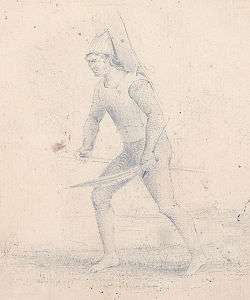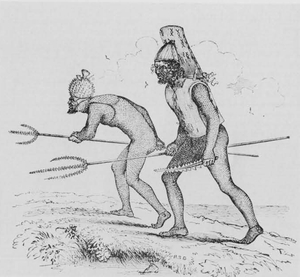Battle of Drummond's Island
The battle of Drummond's Island occurred during the United States Exploring Expedition in April 1841 at Drummond's Island. After an attack by natives on the USS Peacock, the Americans decided on exacting redress for the incident, which they succeeded in doing.[1]
Background
The USS Peacock was commanded by Lieutenant William L. Hudson. Commander of the United States Exploring Expedition Charles Wilkes had ordered Hudson to explore Drummond's Island, so-named after a member of the expedition. Lieutenant Hudson learned from a member of his crew that a merchant ship had wrecked on a reef off the island's northwest coast years before. Most of its crew was massacred, except for a "white woman" and a child—who were supposed to still be alive. On April 6, the Peacock anchored off Utiroa on Drummond's Island. Hudson went ashore with a couple of Navy officers, a marine detachment, as well as the Scientific Corps.
Initially, the natives were described as peaceful; they led the Americans to their village center. Tabiteuea means "land of no chiefs" in Gilbertese, and the natives themselves practiced egalitarianism, which meant the Americans had no tribal chief, or leader, to consult with.[2]
Utiroa was said to be where the massacre had taken place; other than studying the flora and fauna of the island, Hudson wanted to inquire about the shipwreck and the stranded woman and child. The natives spoke nothing of the incident but "parts of the vessel were found" inside the village's huts, though most of the buildings were deemed off-limits.[3]
The Americans returned to their ship after several hours, but returned the next day, on April 7. All was well until Lieutenant Hudson and his men were on their way back to the Peacock. They noticed that a member of the procession, seaman John Anderson, was missing. A search was undertaken whch went unnoticed by the Gilbertese, who appeared to be arming themselves with swords, spears, and other weapons.
Eventually, the search was discontinued and as the Americans were boarding their gig and armed boats, the natives tried to surround the sailors and marines. The natives threw rocks and waved their weapons as the boats shoved off. No one was harmed; Lieutenant Hudson decided to wait for Anderson until April 9, by which time the USS Flying Fish had arrived.[3]
Battle
After it became apparent that the sailor would not return, Hudson attacked the town to administer punishment. About eighty marines and sailors under Lieutenant William M. Walker of the Marine Corps were divided into three sections and landed at daylight. Meanwhile, the Peacock maneuvered into firing position off Utiroa and the Flying Fish covered the landing of men in seven boats. In case the landing party was overwhelmed, the schooner would provide covering fire and rescue the survivors.

Around 700 Gilbertese warriors were dancing in the jungle near the beach and as the boats pulled in, Lieutenant Walker shouted a warning to let Seaman Anderson go. The demand was ignored and the natives entered the water and headed for the boats, forcing them to retreat a little ways. After this Walker turned his boats around and opened fire with a rocket at the mass of warriors. He then ordered his men to begin volley fire and devastated the natives according to the Peacock's log book. A little while later the natives "fled to the bush" so the American vessels pulled in closer to shore, within "pistol shot" range. Then the landing was made.[4]
The Gilbertese were not gone for long, many returned to defend their villages and they unsuccessfully skirmished with Americans for hours. When all the buildings of Utiroa were burned, Walker and his men moved on to another nearby village and destroyed it as well. They then tried to inquire about the shipwrecked survivors but again nothing was uncovered so Lieutenant Walker led his men back to the boats.
There were no American combat casualties but the armed boats were damaged in some way during the action and they were repaired aboard USS Peacock as she sailed to rejoin Commander Wilkes in the sloop-of-war USS Vincennes with the USS Flying Fish in company. Twelve islanders were killed in the fighting and others were wounded. Later during the expedition, the Peacock sank without loss of life in July 1841, while sailing into the mouth of the Columbia River.[5]
Similiar expeditions
- First Sumatran Expedition of 1832
- Second Sumatran Expedition of 1838–1839
- First Fiji Expedition of 1855
- Second Fiji Expedition of 1859
- Nukapu Expedition of 1871–1872
References
Bibliography
- Ellsworth, H. A. (1934). One Hundred Eighty Landings of United States Marines 1800 to 1934. Washington D.C.: US Marines History and Museums Division.
- Macdonald, B. (2002). Cinderellas of the Empire: Towards a history of Kiribati and Tuvalu. London. ISBN 982020335X.
This article incorporates text from the public domain Dictionary of American Naval Fighting Ships.
